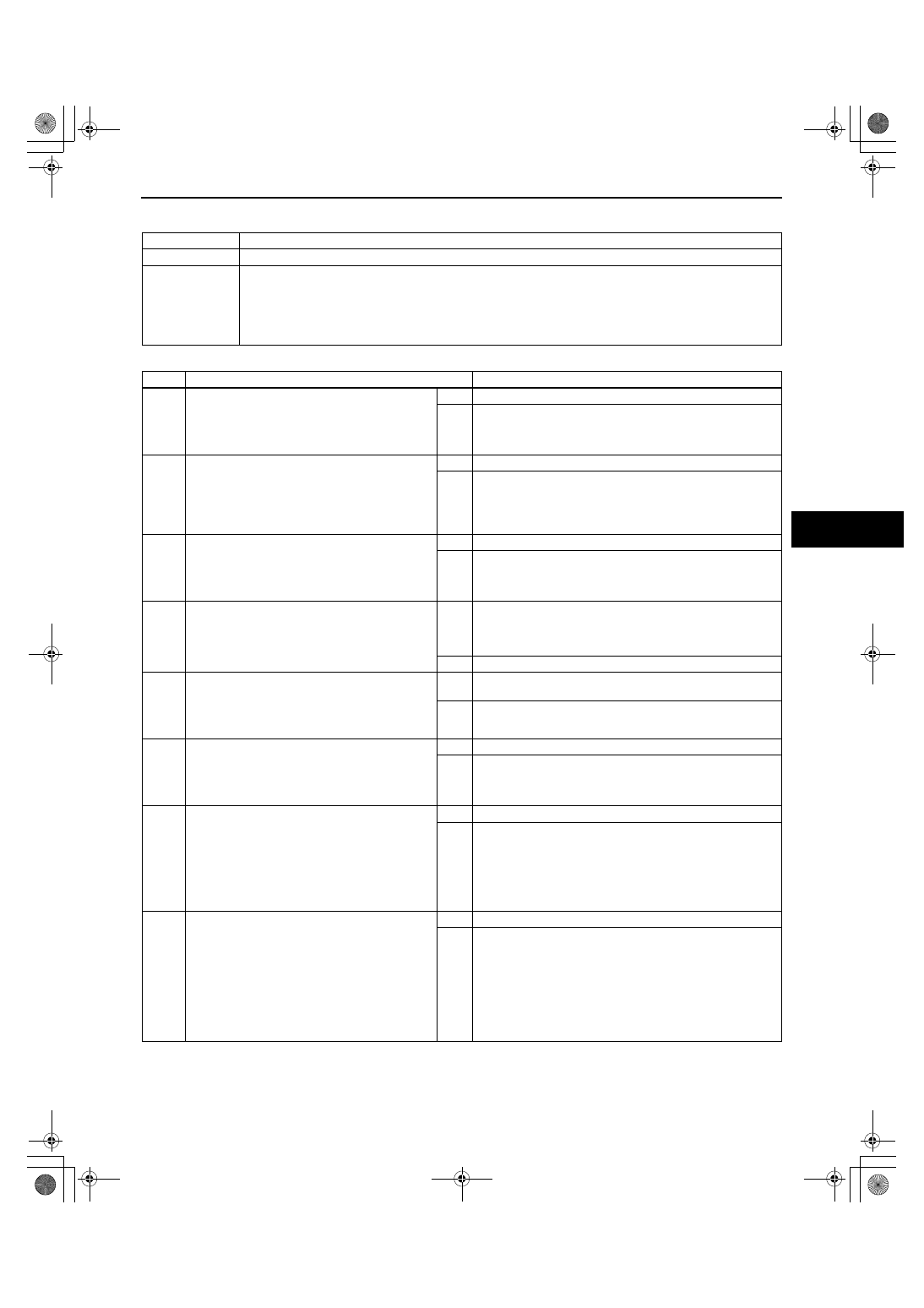Mazda CX 7. Manual - part 285

SYMPTOM TROUBLESHOOTING
07-03–13
07-03
NO.7 AIR FROM VENTS NOT COLD ENOUGH
id070300801000
Diagnostic procedure
7
Air from vents not cold enough.
DESCRIPTION
• Magnetic clutch operates but A/C system malfunctions.
POSSIBLE
CAUSE
• Drive belt malfunction
• A/C unit or condenser malfunction
• Receiver/drier or expansion valve malfunction (valve closes too much)
• Malfunction in refrigerant lines
• A/C compressor system malfunction, insufficient compressor oil
• Over filling of compressor oil, malfunction in expansion valve or A/C unit air mix link system
STEP
INSPECTION
ACTION
1
INSPECT DRIVE BELT
• Inspect the drive belt.
(See 01-10-3 DRIVE BELT INSPECTION[L3
WITH TC].)
• Is it normal?
Yes
Go to the next step.
No
Adjust or replace the drive belt, then go to Step 20.
(See 01-10-3 DRIVE BELT REMOVAL/INSTALLATION[L3
WITH TC].)
2
INSPECT REFRIGERANT SYSTEM
PERFORMANCE
• Perform refrigerant system performance test.
(See 07-10-6 REFRIGERANT SYSTEM
PERFORMANCE TEST.)
• Is the operation normal?
Yes
Operation is normal. (Recheck malfunction symptoms.)
No
Go to the next step.
3
INSPECT TO SEE WHETHER MALFUNCTION
IS IN A/C UNIT INTAKE AND CONDENSER
OR ELSEWHERE
• Are the refrigerant high-pressure and low-
pressure values both high?
Yes
Go to the next step.
No
Go to Step 6.
4
INSPECT A/C UNIT INTAKE
• Is the A/C unit intake clogged?
Yes
Remove obstruction, then go to Step 20. (If air does not
reach the evaporator in the A/C unit, heat exchange does
not occur and refrigerant pressure becomes high.
Therefore, removal of obstruction is necessary.)
No
Go to the next step.
5
INSPECT CONDENSER
• Inspect the condenser.
(See 07-11-18 CONDENSER
INSPECTION.)
• Is it normal?
Yes
Adjust refrigerant to the specified amount, then go to Step
20. (Excessive amount of refrigerant.)
No
Replace the condenser, or repair and clean the condenser
fins, then go to Step 20.
6
INSPECT TO SEE WHETHER MALFUNCTION
IS IN EXPANSION VALVE, RECEIVER/DRIER
AND REFRIGERANT LINES OR ELSEWHERE
• Are the refrigerant high-pressure and low-
pressure values low?
Yes
Go to the next step.
No
Go to Step 14.
7
INSPECT TO SEE WHETHER MALFUNCTION
IS IN EXPANSION VALVE AND RECEIVER/
DRIER OR ELSEWHERE
• Immediately after the A/C compressor
operates, does the refrigerant high-pressure
value momentarily rise to correct value, then
fall and stay below it? (Is there negative
pressure on low-pressure side?)
Yes
Go to the next step.
No
Go to Step 10.
8
INSPECT TO SEE WHETHER MALFUNCTION
IS IN EXPANSION VALVE OR RECEIVER/
DRIER
• Turn the A/C switch off and let the air
conditioner stop for 10 min.
• Start the engine.
• Turn the both A/C switch and airflow volume
control dial on.
• Does the malfunction occur after the A/C
compressor turns on?
Yes
Go to the next step.
No
Replace the condenser and vacuum the refrigerant line
more than 30 min by the vacuum pump, add refrigerant to
the specified level, then go to Step 20. (Since water has
intermixed in the receiver/drier and it is saturated,
replacement is necessary.)
1871-1U-06B(07-03).fm 13 ページ 2006年3月15日 水曜日 午前11時28分